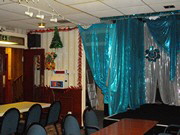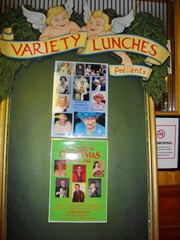Wood Green Social Club, London
Wood Green Social Club,
3 Stuart Crescent, Wood Green, London N22 5NJ
020 8888 9917
Fax 020 000 2747
Nearest Tube- Wood Green (Piccadilly Line)
Buses- 329, 121, 141
Email- woodgreensocialclub@tiscali.co.uk
A few minutes walk away from north London’s busy Wood Green Shopping City and the tube station, you will find a haven in Wood Green Social Club whose origins can be traced back to first decade of  the 20th century. Although now housed in a very functional looking 60s building, perhaps not the most pleasing of architectural styles, you can find a warm welcome inside. It is a club with a modern appearance but has over a hundred years of fascinating history that the current committee and members are proud of.
the 20th century. Although now housed in a very functional looking 60s building, perhaps not the most pleasing of architectural styles, you can find a warm welcome inside. It is a club with a modern appearance but has over a hundred years of fascinating history that the current committee and members are proud of.
It began life as the Southgate and Wood Green Labour Club and had very strong links with the local Labour party and trades unions. Wood Green was and still is a transport hub with nearby rail stations of Hornsey, Alexander Palace and Finsbury Park so there were close ties with the NUR and ASLEF. Many committed local Labour party and trade union activists wanted to set up a club where they could have their own base for political meetings and the like as well as a recreational space.
A committee was formed in 1910 with the aim of establishing such a base for activists, a club, for the Wood Green and Southgate area. In the history of the club written by Michael Kent we read that: ‘The committee was comprised of working men with a common ideal, to triumph over adversity and succeed in controlling their own destiny. (M Kent ‘Forward Together: a short history of Wood Green Labour Club and Institute’, p. 6) The committee wished to model their club on existing working men’s clubs that had been set up during the latter half of the 19th century. There were already around 160 clubs in London when the Wood Green committee began their quest to establish theirs.
One of the key movers and shakers on the original committee was Henry Tudor-Rhys, a prominent activist who ‘lived, breathed and ate politics.’ (Kent, p. 13) He was to become the first President of the club. Back then, many ordinary people were actively involved in political struggles such as for decent pay and conditions at work.
It took some time to find suitable premises and the club was sited for a while in Spouters Corner, Lordship Lane and Commerce Road. The club registered under the Industrial and Provident Societies in 1920, making it a legal entity. There were debates amongst the committee about what sort of club it should and whether or not it should sell beer. The original aim of the Club and Institute Union (CIU), the umbrella organisation for clubs, was to promote teetotalism. But working men setting up clubs had pressed for a choice in this matter so by the early decades of the 20th century, most clubs had a bar. Beer was in many ways the staple drink of the working classes. In the early 20s, suitable premises were found in the form of Stirling House, on Stuart Crescent, close to the corner of White Hart Lane, but the price of £1,750 was far beyond their means, even after various fundraising schemes. They were fortunate enough to have a wealthy supporter in the form of local newspaper proprietor William Joseph Neal, editor of Wood Green’s Sentinel and Weekly Herald. This was good news but the condition was that the club did not sell alcohol as Neal was an old-school teetotal, democratic, Christian socialist. The club remained ‘dry’ until 1949 when the first bar was put in.
In the early 20s, suitable premises were found in the form of Stirling House, on Stuart Crescent, close to the corner of White Hart Lane, but the price of £1,750 was far beyond their means, even after various fundraising schemes. They were fortunate enough to have a wealthy supporter in the form of local newspaper proprietor William Joseph Neal, editor of Wood Green’s Sentinel and Weekly Herald. This was good news but the condition was that the club did not sell alcohol as Neal was an old-school teetotal, democratic, Christian socialist. The club remained ‘dry’ until 1949 when the first bar was put in.
Early club activities included concerts, whist drives, political meetings and rallies with outdoor rallies and sporting events in the land around Stirling House which was included in the purchase price. There were also educational talks and even elocution lessons!
The club was ahead of some others in the involvement of women right from the start, some of who sat on the committee in the 1920s. These were highly politicised women who had been involved in the Labour and Suffragette movements. One such woman was Jenny Bolster, who was later to become the first Lady Mayor of Wood Green. During the General Strike, the club was a centre for rallies and marches as well as place where those on strike could find a bit of help.
The club was very quickly a popular place and needed to extend the premises. Money was raised from the membership for this and the new hall opened in 1927. They wanted someone high profile from the Cabinet to open the new hall and were offered J H Thomas, General Secretary of the NUR, or Oswald Mosley, at that time the Labour Minister of Employment. They chose the latter, not knowing that this man would go on to lead the British Union of Fascists. Hundreds came for the Grand Gala opening event and the club went on to become a social as well as social centre for the Wood Green area. The new hall was a ‘firm favourite’ with members with dances, concerts and other activities.
After the War, the club remained a popular place but had to compete with other leisure activities including home-based ones such as TV, which was rapidly gaining in popularity. The political side of the club was on the wane, as it was in clubs across the country. The welfare state, a new education system and council housing seemed to signal for many working class people that their battles were won. And after years of hardship and austerity during the war, they wanted to have a bit of fun. This added to the pressure for the club to have a bar and after buying out the shares of Joseph Neal’s widow, the way was clear for this.
The President of the Club in this period was Cllr Vic Butler, another prominent local Labour Party member. He was also a JP and became first Mayor of Haringey, 1965-66. He was Club President from 1958-82 and then immediately became Secretary.
Vic Butler did a lot for the club as well as being involved with the planning and development of Wood Green Shopping Centre. Plans for extending the club were laid and after some difficulties, including objections from those living in houses nearby, they got their permission. The old hut, which many older Wood Green members have fond memories of, was demolished whilst other parts of the club were refurbished. The new club that we recognise today was opened in 1970 but other updates were carried out over the next decade or so, including to the snooker hall. The club is now on two storeys with a function room above the main bars and concert room. The ‘Vic Butler Suite’ was opened in 1985 and is still there today, in memory of the man who achieved so much for the club and its members.
As with many other clubs, the situation today is difficult. Many members have grown old and passed away, whilst younger ones moved away. With so many pubs around the area offering cheap booze, the club has a lot of competition. But they also have a lot of commitment from its committee and steward, Alan Roberts, who has been involved with clubs for most of his adult life. He has done just about all the jobs that clubs need doing, from sitting on the committee, to doing plastering and decorating!
We can see many links with local Labour Party dignitaries and politicians, going back to its early years. Today’s political situation is more complex and the trade unions, which once put so much enthusiasm into clubs, now themselves struggle.
Wood Green Social Club, as it is now known, still has a lot to offer.
They are open most days, including lunchtimes.
Sports and Games
2 mixed darts teams.
2 ladies darts teams.
1 football team (Edmonton League).
2 crib teams.
2 pigeon clubs.
Snooker tables and darts board for all members.
Sky TV for all the major games and racing. Entertainment and Bingo
Entertainment and Bingo
Saturday and Sunday bingo.
Disco once a month.
Live band and singer on Sunday.
The popular entertainer Micky Driver puts on regular shows at the club around certain themes such as ‘Swingin’ the 60s’, ‘Stars and Songs of World War 2’ and the popular musicals. Lunch is usually included in the price of the ticket.
The club is conveniently located for the Tottenham Hotspur football ground, at the other end of White Hart Lane so if you are going that way, why not pop in for a pre-or post match pint? Take your CIU Associate Pass card with you for entry.
If you are not a member of a CIU club, why not think about joining?
Ruth Cherrington
December 2011
